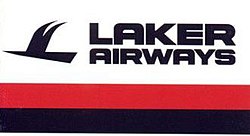Laker Airways
 |
|||||||
|
|||||||
| Founded | 1966 | ||||||
|---|---|---|---|---|---|---|---|
| Ceased operations | 5 February 1982 | ||||||
| Hubs |
London Gatwick Airport Berlin-Tegel Airport |
||||||
| Secondary hubs | Manchester Airport | ||||||
| Focus cities | Glasgow Prestwick | ||||||
| Subsidiaries | [International] Caribbean Airways (part-owned) Laker Air Travel Ltd. Arrowsmith Holidays Ltd. Laker Holidays GmbH |
||||||
| Fleet size | 20 aircraft (14 widebodies and six narrowbodies) at 5 February 1982 | ||||||
| Destinations | Europe/North America/Asia | ||||||
| Company slogan | Take a Laker! (mid-'70s) | ||||||
| Parent company | Laker Airways (Leasing) Ltd. | ||||||
| Headquarters | London Gatwick Airport | ||||||
| Key people | Sir Freddie Laker, Alan Hellary, John Seear, Peter Yeoman, Bill Townsend, Cliff Nunn, John Jones, Richard Boyton. US opers., Dennis Crosby, Phillip (Randy) Cover, Charles Wallace, Bill Razack, David Morales, Kevin McGraw, Holly Sprayberry. | ||||||
Laker Airways was a wholly private, British independent airline founded by Sir Freddie Laker in 1966. It originally was a charter airline flying passengers and cargo worldwide. Its head office was located at London Gatwick Airport in Crawley, England.
It became the second long-haul, low-cost, "no frills" airline in 1977, operating low-fare scheduled services between London Gatwick Airport and New York City's John F. Kennedy Airport (after pioneering Icelandic low-cost carrier Loftleiðir). The company did not survive the recession of the early 1980s and operated its last flight on 5 February 1982, the day it went bankrupt.
Freddie Laker unveiled his airline – Laker Airways – to the press in February 1966. The airline commenced commercial operations from its London Gatwick Airport base on 29 July 1966 with two former British Overseas Airways Corporation (BOAC) Bristol Britannia 102 series turboprops, initially operating under contract to Air France. The aircraft's livery was a combination of black, red and white – an adaptation of Laker's racing colours. The Britannias were supplemented and eventually replaced by five BAC One-Eleven 300 short-haul jet aircraft from December 1967. This included an initial order for three aircraft valued at £4 million. Laker had placed this order directly with the manufacturer in 1966. He provided more than £200,000 of his own money for the newly ordered aircraft's deposits and arranged for the remainder to be borrowed from a consortium of City banks led by Clydesdale Bank. He placed a follow-on order for a fourth aircraft to be delivered in 1968 and acquired another relatively new aircraft that was originally delivered to the failed British Eagle airline from Bahamas Airways in 1971. These were the mainstay of the fleet for its short- and medium-haul charter operations to holiday resorts in the Mediterranean and the Canary Islands for many years.
...
Wikipedia
